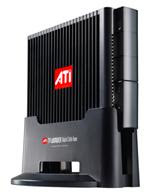SUNNYVALE, Calif., Nov 17, 2008 (BUSINESS WIRE) -- AMD (NYSE: AMD) today announced that its Quad-Core AMD Opteron(TM) processors are powering "Jaguar," the first ever wholly x86-based supercomputer to achieve the petaflop performance milestone. AMD Opteron processors now help drive seven of the Top 10 supercomputer systems in the world.
The AMD Opteron processor-based and IBM PowerXCell processor-based "Roadrunner" system at Los Alamos National Labs again captures the number 1 spot on the bi-annual TOP500 Supercomputer Sites list, while the "Jaguar" supercomputer at Oak Ridge National Laboratory comes in at number 2 and is the highest performing entirely x86-based system ever on the survey. "Jaguar" is based on Cray XT4 and XT5 systems and runs on over 45,000 Quad-Core AMD Opteron processors, enabling a balanced system with unrivaled x86 performance.
"Today's TOP500 Supercomputing Sites list reaffirms AMD's leadership and the tremendous performance capability that HPC customers have enjoyed for years," said Patrick Patla, vice president and general manager, Server Workstation Division, AMD. "Seven of the ten most powerful computing systems in the world now leverage the balanced platform of our Direct Connect Architecture. Our commitment to the HPC community only gets stronger with the recent launch of our 45nm Quad-Core AMD Opteron processor which has already set new standards in HPC performance." In addition to seven of the premium top ten, AMD Opteron processors have helped catapult 53 other global supercomputers on the TOP500 to newheights of HPC performance. Today's list highlights industries of all types that are harnessing AMD's world-class computing capability including IT service providers, financial institutions, automotive design, and researchers in energy, geology, meteorology, social sciences, astronomy and many other disciplines.
Recently, AMD announced widespread availability of its 45nm Quad-Core AMD Opteron processors, codenamed "Shanghai." These latest Quad-Core AMD Opteron processors already hold multiple HPC workload-related performance records including: -- 34 percent higher floating point throughput performance than the competition on SPECfp(R)_rate2006 for two-socket servers -- 51 percent more memory bandwidth performance than the competition on STREAM benchmarks for two-socket servers -- Approximately 65 percent faster job runs than the competition on FLUENT 12 beta (ANSYS) for two-socket servers -- More than 30 percent better performance than the competition on LSDYNA MPP971s for two-socket servers.
Additionally, readers of HPCWire this week voted "Shanghai" as one of the Top 5 New HPC Products or Technologies to Watch.
About AMD Advanced Micro Devices (NYSE: AMD) is an innovative technology company dedicated to collaborating with customers and partners to ignite the next generation of computing and graphics solutions at work, home and play. For more information, visit http://www.amd.com.
AMD, the AMD Arrow logo, AMD Opteron, and combinations thereof are trademarks of Advanced Micro Devices, Inc. Other names are for informational purposes only and may be trademarks of their respective owners.
SPEC and SPECfp_rate2006 are registered trademarks of the Standard Performance Evaluation Corporation.
1. Comparison based on SPECfp(R)_rate2006. Results for Quad-Core Intel Xeon processor Model E5472 published on www.spec.org as of October 27, 2008. Results for Quad-Core AMD Opteron(TM) processor Model 2384 based upon data submitted to Standard Performance Evaluation Corporation. Results published on amd.com as of November 13, 2008. See http://www.amd.com/us-en/Processors/ProductInformation/0,,30_118_8796_8800,00.html.
For the latest SPECfp(R)_rate results, visit http://www.spec.org/cpu2006/results/.
System configurations: "Shanghai": 2 x Quad-Core AMD Opteron(TM) processors Model 2384 in Supermicro A+ Server 1021M-UR+B motherboard, 32GB (8x4GB DDR2-800) memory, 300GB SATA disk drive, SuSE Linux(R) Enterprise Server 10 SP1 64-bit Xeon: 2 x Quad-Core Intel Xeon processors Model E5472 in Supermicro X7DWN+ motherboard, 32GB (8x4GB DDR2-800 FB-DIMM) memory, 74.8GB SATA disk drive, SuSE Linux(R) 10 SP1 64-bit.
http://www.spec.org/cpu2006/results/res2007q4/cpu2006-20071112-02546.html 2. STREAM: Comparison based STREAM benchmark measurements performed at AMD performance labs as of October 27, 2008. STREAM results represent Add, Copy, Scale, and Triad performance. Results published on amd.com as of November 13, 2008. See http://www.amd.com/us-en/Processors/ProductInformation/0,,30_118_8796_8800,00.html.
System configurations: "Shanghai": 2 x Quad-Core AMD Opteron(TM) processors Model 2384 in Supermicro H8DMU+ motherboard, 16GB (8x2GB DDR2-800) memory, 150GB IDE disk drive, SuSE Linux(R) Enterprise Server 10 SP2 64-bit.
Xeon 5472: 2 x Quad-Core Intel Xeon processors Model E5472 in Supermicro X7DWN+ motherboard, 16GB (8x2GB DDR2-800 Low-Power FB-DIMM) memory, 150GB IDE disk drive, SuSE Linux Enterprise Server 10 SP2 64-bit.
3. FLUENT 12 beta (ANSYS) sedan_4m and LSDYNA MPP971s: Comparisons based on 2 x Quad-Core AMD Opteron(TM) processors Model 2356, 2384 in Supermicro H8DMU+ motherboard, 16GB (8x2GB DDR2-800), 150GB IDE disk drive, SuSE Linux(R) Enterprise Server 10 SP1 64-bit and 2 x Quad-Core Intel Xeon processors Model E5472 in Supermicro X7DWN+ motherboard, 16GB (8x2GB DDR2-800 FBDIMM, low power), 150GB IDE disk drive, SuSE Linux (R) Enterprise Server 10 SP1 64-bit. All results based on internal testing at AMD Performance Center of Excellence except competitive data in clusters which is publically available. Performance on final FLUENT software release may vary. Results published on amd.com as of November 13, 2008. See http://www.amd.com/us-en/Processors/ProductInformation/0,,30_118_8796_8800,00.html.
SOURCE: AMD CONTACT: AMD Public Relations Teresa Osborne, 978-795-2506(PR) teresa.osborne@amd.com or Ruth Cotter, 408-749-3887 (IR) ruth.cotter@amd.com Copyright Business Wire 2008 -0- KEYWORD: United States
North America
California INDUSTRY KEYWORD: Technology
Hardware
Internet
Networks
Software
Telecommunications
Other Technology SUBJECT CODE: Product/Service
Read more ...............





 The bad: Even the best TV tuner has a worse image than a standard cable signal; CableCard will make other TV tuners obsolete next year.
The bad: Even the best TV tuner has a worse image than a standard cable signal; CableCard will make other TV tuners obsolete next year.








